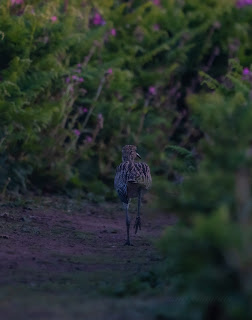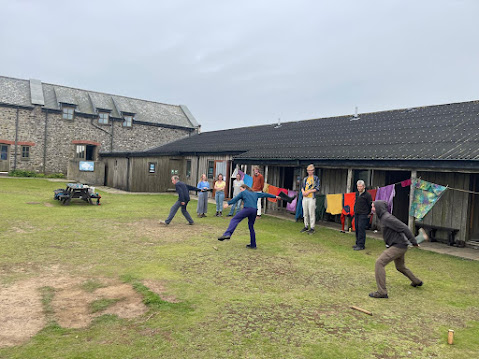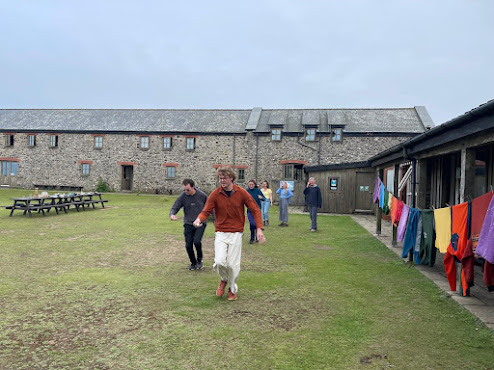An August / Early September Update
Events:
Black to Nature
Our events season for 2025 was kicked off with a visit from a group of 11-16 year olds from the Black to Nature group based in Bristol. This group aims to increase access to nature for young people from visible minority ethnic groups. The group got involved in a range of activities including moth trapping, a bird race, rockpooling and seal pup watching!
Day 1 involved an introductory walk and wildlife spot around the island - it was good day for it with plenty of birds and a group of Common Dolphin making an appearance at Garland Stone. Day 2 started off with moth trapping. Despite the early start the group got stuck in with our moth matching game - learning to differentiate between a campion and lychennis and recognise the shapes and patterns on everything from cetacous hebrew character to a spectacled moth. There were high stakes in the final rounds of moth matching - with several of the young people giving Rob our Visitor Officer a run for his money! Later on the group headed out to see the seal pups from Captain Kites and went down to North Haven for some rockpooling. The group had some fantastic finds including Cornish Sucker Fish, a Porcelain Crab, a Common Prawn, Velvet Swimming Crabs and Edible Crabs. Day 3 was the bird race and island scavenger hunt - where the group were split into smaller teams to find a series of items around the island beginning with each letter of the alphabet and as many different bird species as they could. The day was finished off with a quiz and prizes for the winners of each activity! We had a fab time with the group and we look forward to seeing them back next year!
 |
A group of young people on the Black to Nature trip exploring the island with Assistant Warden Ceris. |
Manx Shearwater Week
We had three groups come out to the island for Manx Shearwater Week this year to learn more about these fantastic birds that are so special to Skomer. Groups had a talk from the Oxford University Navigation group that conducts Manx Shearwater research on the island and a chance to have a go at chick weighing with them! Evenings on the island were spent looking for rafting manxies off the coast before heading out at night to see the fledglings. In spite of some slightly mixed weather the week was greatly enjoyed by all!
Yoga Week, Art Week and Folk Music Week
Some of our creative events this year included our yoga, art and folk music weeks! Despite a delayed start to the yoga week with the stormy weather, the group enjoyed exploring the island and practising yoga in some scenic spots around the coast of the island. Our Art week group had a go at a variety of techniques to capture some of Skomer's natural beauty including cyanotyping and ink work which produced some beautiful results. Everyone on the island enjoyed a viewing of the artwork set up on the final evening! The Folk music week was a fantastic event - hearing folk music playing around the farm and courtyard throughout the day was particularly special, and everyone enjoyed sitting around the hostel lounge of an evening listening to the group play. On the last evening we had a Ceilidh in the courtyard which was fantastic fun (although featuring some slightly questionable dancing skills) - it was the first Ceilidh held on Skomer that we know of!
 |
| An evening performance from the folk music group. |
 |
| The end of week viewing of the Art Group's work. |
Young Birders Week
We had two groups of young people age 18-25 visit us for Young Birders Week in early September. This event is also aimed at increasing access to nature, in particular for young people. The groups enjoyed exploring the island, moth trapping and watching seals and cetaceans around the coast. Whilst looking for cetaceans we decided to try and work out how many Young Birders Long (YBL) various cetacean species are. We measured everything from a Harbour Porpoise (1 Young Birder Long / YBL) to a Humpback Whale (16 YBL = 1 YBG/ Young Birders Group)! To finish off the week the groups, staff and volunteers enjoyed taking part in a (very competitive) bird race, with some fantastic sightings all round. We were all impressed by the fantastic creativity on display with the team names for the bird race, including the 'Alpha Shearwater Squadron', Puffin it to win it' and 'Volun-Shearwaters'!
 |
| A Harbour Porpoise is 1 YBL (Young Birders Long) |
 |
| A Humpback Whale is 16 YBL = 1 YBG (Young Birders Group) |
Autumn Migration Sightings and Wildlife Updates
The last few weeks has had some great birds seen around the island with Autumn Migration. Some particular highlights from August included a Wryneck, a Western Bonelli's Warbler and a Spoonbill flying over the island! With stormy weather in September we headed out sea watching and saw Arctic Skuas, Great Skuas, Pomarines Skuas, Sabine's Gull, Black Terns, Comic Terns, Arctic Terns and even several Grey Phalarope!
Seals have been keeping Will and Anna busy, with us now being in the midst of pupping season! We are currently up to about 130 pups around the island coast! Seal pups are graded based on age and condition and monitored as part of the fieldwork on the island.
Some of the more varied weather over the last couple of months has lead to some fantastic views and photos around the island which I've included below.
 |
| Lightning striking over the trig point. |
 |
| A sunrise over Captain Kites. |
 |
| A double rainbow in North Haven. |
 |
| Some stormy seas at Pigstone Bay. |
 |
| An evening sea watch at Pigstone Bay. |
A Hwyl Fawr From Me
I've had the most amazing time as an LTV here over the last three months am very sorry to be leaving this week! I've learnt so much and am very grateful for the opportunity I've had. Skomer is somewhere I've loved visiting since since I was very small and to be able to come over here as an LTV has been a fantastic experience. A big thank you to all the birds, people and other wildlife that have made it so special!
Diolch yn fawr am ddarllen!
Anna
Long Term Volunteer for July-September.










.jpg)



































